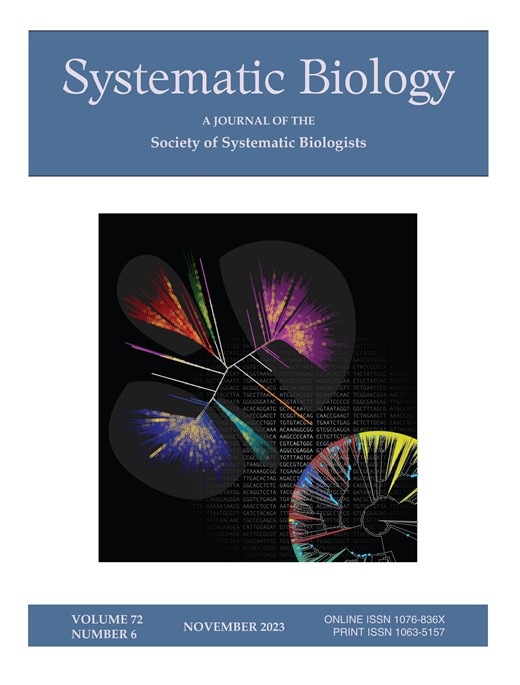隐种可以在系统发育上古老,尽管有强烈的性别偏向性扩散。
IF 5.7
1区 生物学
Q1 EVOLUTIONARY BIOLOGY
引用次数: 0
摘要
在综合分类学的框架下,由于有限的或性别偏向的扩散,强分化种群对物种划界的影响仍然具有挑战性和未被充分探索。地中海的金龟子甲虫属Pachypus因其极端的雌性哲学而引人注目,它们的雌性完全没有翅膀,生活在地下。这使得Pachypus成为一个有趣的研究案例。基于900多个蛋白质编码基因(后生动物通用单拷贝同源基因;mzl-USCOs)的数据集,我们研究了系统发育、物种划分、基因流动和种群分化,以提供物种边界的综合评估。综合考虑所有结果,识别出14个形态上大多隐种,包括几个新的分类群。大多数推断的物种形成事件发生在墨西尼亚盐度危机结束(约530万年前)和更新世早期之间。由于极端的亲缘性、物种的形态相似性和同一物种种群之间观察到的高度分化,在系统发育上发现了古老的物种和缺乏最近的物种形成是出乎意料的。在墨西尼亚盐度危机(MSC)之后,物种形成部分与先前更紧密联系的范围的破坏有关。这也有助于阐明地中海时期地中海干涸的程度,因为第勒尼安周围地区的陆地连接一定持续了足够长的时间,使得不会飞行的雌性肿腹兽分散到连接亚平宁半岛和非洲的漂流陆地上。我们发现了物种之间存在历史基因流动的证据,而最近种群之间的基因流动较少,这可能是贝叶斯系统发育和系统地理(BPP)物种划分分析中发现的相当大的过度分裂的原因。我们发现,将BPP物种划分结果与谱系分化指数(gdi)值相结合,在某些情况下被证明是有帮助的,但在许多其他情况下是不确定的。广义混合Yule聚结(GMYC)和泊松树过程(PTP)分析较少发生过分裂。这说明了物种划界分析如何在有限或性别偏向分散和高度分化种群的情况下,作为划界方法的实用性和稳健性的经验检验。本文章由计算机程序翻译,如有差异,请以英文原文为准。
Cryptic species can be phylogenetically old despite strong sex-biased dispersal.
The impact of strongly differentiated populations on species delimitation due to limited or sex-biased dispersal remains challenging and under-explored in the framework of integrative taxonomy. The Mediterranean chafer beetle genus Pachypus is remarkable for its extreme female philopatry, with entirely wingless and subterranean females. This makes Pachypus an interesting case study. Based on a dataset of over 900 protein-coding genes (metazoan universal single-copy orthologs; mzl-USCOs), we investigated phylogeny, species delimitation, gene flow, and population differentiation to provide an integrative assessment of species boundaries. Integrative consideration of all results led to the recognition of 14 mostly morphologically cryptic species, including several new taxa. Most inferred speciation events occurred in the time between the end of the Messinian salinity crisis (about 5.3 million years ago) and the early Pleistocene. Phylogenetically old species and lack of recent speciation was unexpected because of the extreme philopatry, the morphological similarity of the species, and the high degree of differentiation observed among populations of the same species. Speciation was partly associated with the disruption of previously more connected ranges after the Messinian salinity crisis (MSC). This also helps clarify the extent to which the Mediterranean dried out during the MSC, since land connections in the circum-Tyrrhenian region must have persisted long enough for flightless Pachypus females to disperse across drifting land areas connecting the Apennine Peninsula and Africa. We found evidence for historical gene flow between species, while more recent gene flow between populations is low, which is potentially the cause of considerable over-splitting found in the Bayesian Phylogenetics & Phylogeography (BPP) species delimitation analysis. We showed that integrating the outcome of the BPP species delimitation with genealogical divergence index (gdi) values proved to be helpful in some cases but was inconclusive in many others. Generalized Mixed Yule Coalescent (GMYC) and Poisson Tree Processes (PTP) analyses were less prone to over-splitting. This illustrates how species delimitation analyses of cases with restricted or sex-biased dispersal and highly differentiated populations can serve as empirical tests of the utility and robustness of delimitation approaches.
求助全文
通过发布文献求助,成功后即可免费获取论文全文。
去求助
来源期刊

Systematic Biology
生物-进化生物学
CiteScore
13.00
自引率
7.70%
发文量
70
审稿时长
6-12 weeks
期刊介绍:
Systematic Biology is the bimonthly journal of the Society of Systematic Biologists. Papers for the journal are original contributions to the theory, principles, and methods of systematics as well as phylogeny, evolution, morphology, biogeography, paleontology, genetics, and the classification of all living things. A Points of View section offers a forum for discussion, while book reviews and announcements of general interest are also featured.
 求助内容:
求助内容: 应助结果提醒方式:
应助结果提醒方式:


